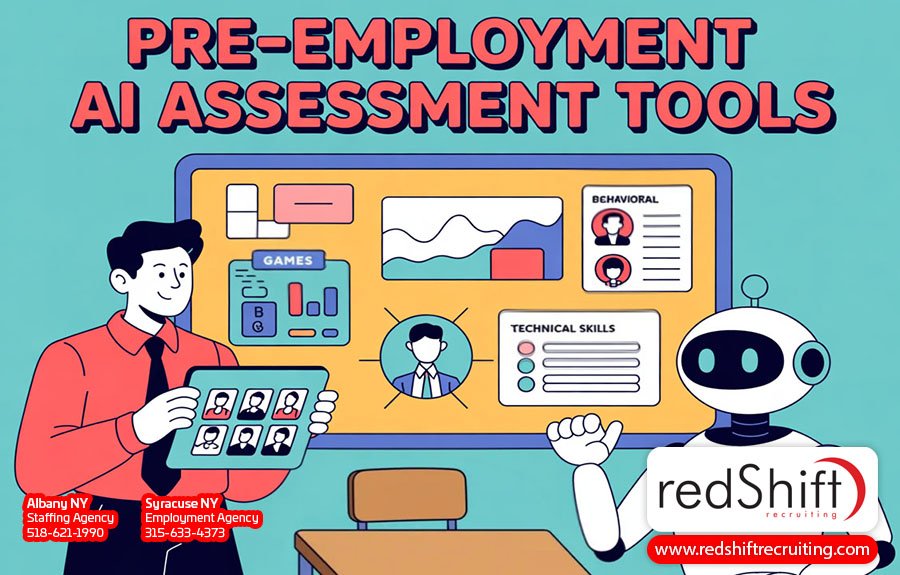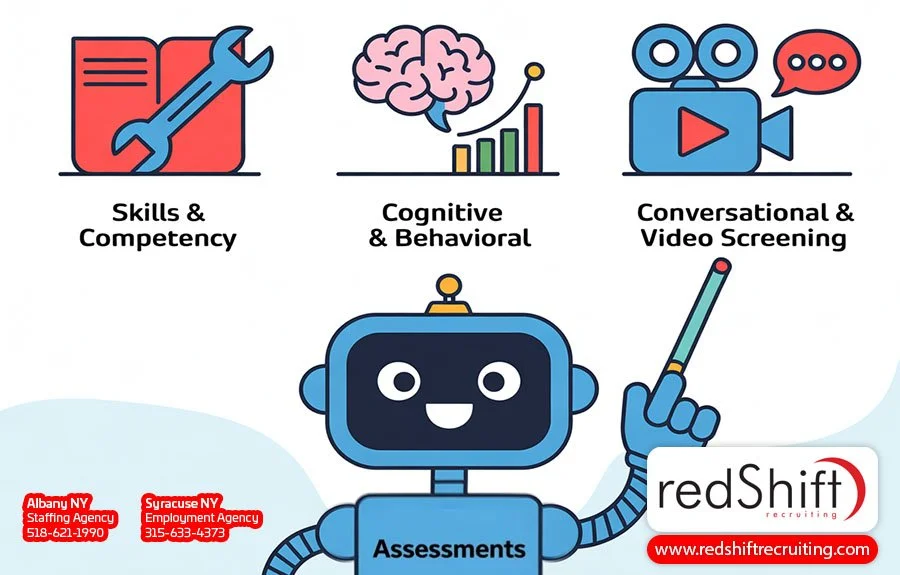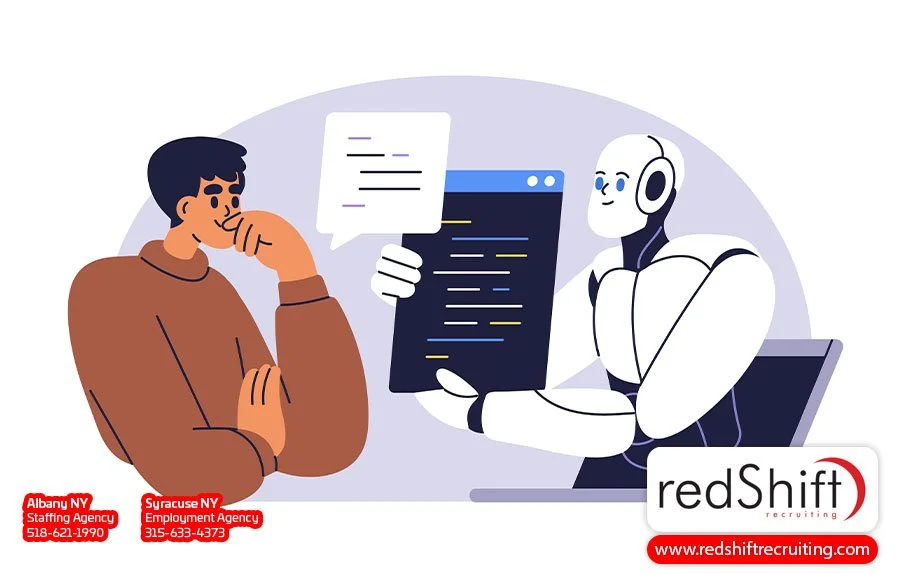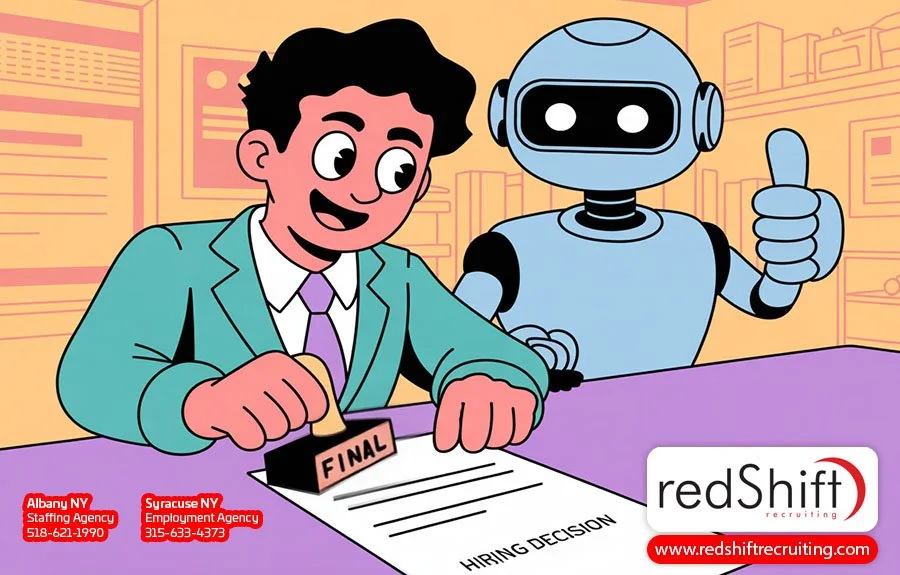Pre-Employment AI Assessment Tools: What They Are, How They Work, and Why It Matters
You’ve got a role to fill: a stack of applications, a calendar packed with interviews, and a hiring manager who needed someone yesterday. But finding the right person takes more than matching keywords on a resume. That’s especially true now, as generative AI tools and job automation platforms make it easy for candidates to apply to hundreds of roles in minutes with little oversight.
Some applicants submit AI-generated resumes filled with inaccuracies or inflated experience. Others use AI tools to pass interviews or even cheat on traditional assessment tests. On the employer side, hiring has become a high-stakes balancing act: speed, fairness, accuracy, and candidate experience all compete for attention. And too often, traditional tools like resumes, keyword filters, application tracking systems, and rapid screening processes favor speed at the cost of insight.
Pre-employment AI assessment tools aim to change that. These tools measure how candidates think, solve problems, communicate, and adapt, offering a clearer picture of true potential. In this article, we’ll explore what these tools can (and can’t) do, how they’re shaping modern hiring, and how to use them thoughtfully as part of a more human, data-informed hiring strategy.
AI Assessment Tools vs. Traditional Hiring Methods
In a typical skills-based hiring process, the first step is often a resume scan. Whether done manually or through automation, this usually favors education, job titles, and keyword matches—factors that don’t necessarily predict future success. From there, hiring teams rely on interviews, where human judgment plays a big role. That’s not always a bad thing—an experienced interviewer can pick up on nuance that a test might miss. But subjectivity also introduces variability: some interviewers are better than others at spotting potential, and unconscious bias can slip in despite the best of intentions. While familiar, these traditional assessment tools can be inconsistent and difficult to scale for large hiring needs, especially in a fast-moving recruitment process.
Pre-employment AI assessment tools offer a different approach. Instead of focusing on what’s on paper, these platforms are designed to assess candidates based on what they can actually do. Many tools offer structured, role-specific tests that measure technical and soft skills alike. And with adaptive testing, the difficulty adjusts in real time based on candidate responses, allowing for a more precise evaluation of technical skills and ability.
Some platforms also use predictive analytics to forecast how someone might perform in the role—based not just on answers, but on behavioral patterns and response timing. This shift toward measuring skills over credentials doesn’t just improve accuracy; it helps reduce bias by standardizing the evaluation experience. By using the same candidate assessment tool under the same conditions, results are easier to compare across a large pool of applicants.
This creates a more consistent and equitable assessment process that improves decision-making while saving time, a crucial advantage whether your screening processes involve hundreds of applicants or just a few top contenders.
Types of AI-Powered Candidate Assessment Tools
Depending on the role, the stage of the hiring process, and the traits you're evaluating, different AI assessment tools serve very different purposes. Some focus on technical performance. Others measure behavioral traits or streamline early-stage screening. Understanding the types of AI-powered assessments available—and what they actually measure—can help you choose the right solution for your hiring needs.
Skills & Competency Testing
For roles where hands-on ability matters most, skills tests are often the foundation of a strong assessment strategy. These tools measure what candidates can actually do, not just what they say they can do.
Platforms like Codility, TestGorilla, Vervoe, and CodeSignal allow employers to run technical assessments tailored to specific job functions. Whether it's grading coding challenges or analyzing written problem-solving tasks, these platforms automate scoring and deliver quick, structured feedback. Some even include developer assessments that mimic real-world programming environments to evaluate practical coding skills.
While the examples above focus on coding and developer assessments, pre-employment tests can evaluate a wide range of technical skills. From Microsoft Excel and data entry to IT troubleshooting, mechanical reasoning, financial modeling, or industry-specific software use, these tools support far more than just developer roles. Platforms like TestGorilla and Vervoe offer libraries of job-relevant skills tests tailored to administrative, customer service, engineering, and accounting positions, helping employers verify hands-on capabilities for a wide range of jobs.
This type of pre-employment test is especially useful for technical roles where accuracy, speed, and applied knowledge matter. It also helps teams assess developers more objectively, removing guesswork from the decision-making process and reducing reliance on resume-based assumptions.
Cognitive & Behavioral Assessments
While technical skills matter, they aren’t the full picture. Companies also need insight into how a candidate thinks, adapts, and fits within a team or company culture.
Tools like Harver (which absorbed the behavioral games created by Pymetrics), Paradox's Traitify, and AssessFirst go beyond traditional testing formats by using interactive, often gamified assessments to evaluate large and diverse groups of applicants. These tools use adaptive logic, real-time data collection, and pattern analysis to deliver more precise cognitive assessments and behavioral assessments than legacy tools. They measure factors like cognitive abilities, emotional intelligence, risk tolerance, and learning agility, all of which offer a window into how someone might handle challenges, solve problems, or collaborate in a real-world environment.
Some platforms also use this behavioral and personality data to generate predictive scores, estimating how likely a candidate is to succeed in a given role or work setting. These insights help hiring teams move beyond gut instinct to more consistent, data-informed decisions.
AI-enhanced situational judgment tests are another valuable tool in this category. Unlike static multiple-choice formats, these tests simulate realistic workplace scenarios, making adjustments based on candidate responses. The AI evaluates how candidates prioritize, communicate, and make decisions, offering deeper insight into judgment and role readiness.
Finally, modern personality assessments are often integrated with AI to interpret subtle trait combinations and match candidates to roles, team dynamics, or company values. Personality traits like adaptability, collaboration style, and stress response are assessed in a more dynamic, scalable way than with traditional surveys alone.
Conversational & Video Screening
When you're reviewing dozens or even hundreds of applicants, efficiency matters—especially in the earliest stages. Platforms like HireVue and Paradox (via its AI assistant, Olivia) help automate the initial screening process by handling early-stage candidate interactions. These tools guide applicants through structured questions and use automated candidate scoring to flag top matches. Some also analyze candidate responses in video interviews, looking at tone, word choice, and structure to evaluate fit.
Earlier versions of these tools experimented with facial expression analysis (FEA). However, leading platforms like HireVue publicly phased out the use of FEA due to mounting legal, ethical, and bias concerns, as well as questions about its scientific validity. Today, the focus remains on consistent structure, accessibility, and analyzing verbal content, tone, and language proficiency, without sacrificing fairness.
Many of these platforms are also mobile-friendly and built with accessibility in mind, helping ensure a smoother candidate experience across devices and backgrounds. Some include language proficiency tests to support multilingual hiring or assess language skills essential to a role.
In addition to improving candidate engagement, most modern platforms integrate directly with applicant tracking systems (ATS) and HRIS platforms. This kind of integration allows for seamless candidate data flow, reducing manual effort for recruiters and supporting a more connected, efficient hiring system.
AI-powered assessment tools reflect the evolution of candidate assessments, from gamified behavioral tests to advanced AI models that generate predictive scores. The key is knowing what to use, when to use it, and how to interpret the results as part of a broader, human-centered hiring strategy.
The Benefits of AI Assessment Tools
When implemented thoughtfully, AI-powered candidate assessment tools can transform the hiring process, making it faster, fairer, and more informed. While the primary appeal is often efficiency, the true benefits lie in the broader impact on decision-making, candidate experience, and long-term workforce strategy. These include:
Efficiency and Scale
AI tools automate high-volume hiring tasks like resume parsing, screening, and scoring, significantly reducing time-to-hire. Whether you're evaluating hundreds of applicants or just a select few, AI helps you move faster without sacrificing depth.
Consistency and Objectivity
By applying the same criteria to every applicant, AI assessments help reduce unconscious bias and inconsistency. Human intuition varies, but an AI-based candidate assessment system scores everyone against the same benchmarks, leading to more confident hiring decisions.
Enhanced Candidate Experience
From gamified tests to conversational chatbots and realistic job previews, many AI assessments are designed to feel less intimidating than traditional interviews or paper tests. This makes candidates more comfortable (and, consequently, often more engaged) while providing better insight into how they might perform on the job.
Customization and Flexibility
With features like an AI assessment builder, employers can create custom assessments aligned to specific roles, departments, or skill sets. Whether you're testing cognitive ability, technical knowledge, or soft skills, the format of customizable assessments can be tailored to match the demands of the job.
Smarter Hiring Decisions
AI assessments go beyond resumes to evaluate how people think, solve problems, and adapt. By using predictive analytics, these tools highlight candidates who may not check every box on paper but are more likely to succeed based on traits tied to real-world performance. This leads to better retention and on-the-job results.
Workforce Intelligence
Many tools provide detailed reporting on assessment outcomes, identifying patterns in skills, strengths, and areas for development. This data can be used to map internal mobility potential, predict success, plan for future hiring needs, and even identify leadership potential.
Seamless System Integration
Leading platforms integrate directly with your applicant tracking system (ATS) or HRIS, streamlining your recruitment process and centralizing data. This means less manual effort, fewer errors, and a more cohesive view of where each candidate is in the process.
Ultimately, AI assessment tools can't replace human judgment, but they can enhance it. By providing structure, insight, and predictive data, they allow recruiters and hiring managers to make faster, more accurate, and more equitable decisions that benefit both the company and the candidate.
The Challenges and Risks of AI Assessment Tools
While AI-powered assessments offer clear benefits, they also come with limitations. Understanding these risks is essential to avoid overreliance, ensure fairness, and protect your employer brand. A few key factors to be aware of include:
Algorithmic Bias
AI systems trained on historical hiring data may reflect and reinforce existing biases, especially if past decisions favored certain demographics or credentials. Even well-intentioned tools can produce unfair outcomes in certain cases, such as when assessing neurodivergent candidates or non-native speakers.
Lack of Transparency
Many AI tools operate as “black boxes,” making it difficult to explain why a candidate was advanced or rejected. Some tools offer precise-sounding scores in the assessment data (e.g., “92% job fit”) without a clear explanation of how these calculations were made. This can mislead evaluators, reduce accountability, and make audits or appeals nearly impossible—even though these scores are often based on subjective or surface-level variables that don’t fully capture a candidate’s true potential.
Unequal Access to Resources
Candidates from lower-income backgrounds or digitally underserved communities may lack access to the devices, internet speeds, or practice materials required to perform well on gamified or video-based assessments. This raises concerns about digital accessibility and fairness, and may also undermine diversity and inclusion efforts.
Cheating and Manipulation
Generative AI tools make it easier for job candidates to game assessments, whether by scripting chatbot responses or using AI to assist with pre-hire tasks. This poses challenges in how organizations maintain test integrity, especially for unsupervised evaluation formats or remote roles.
Loss of Human Nuance
AI can’t reliably evaluate emotional intelligence, cultural fit, or interpersonal dynamics in ways that reflect context or soft skills, and yet these traits are crucial to building effective teams and a strong company culture. Human qualities are best assessed through personal interaction, such as structured interviews, collaborative exercises, or direct conversation, where nuance and authenticity can be observed.
Overreliance Reduces Accountability
Relying too heavily on AI evaluation tools may discourage hiring teams from asking critical questions or applying professional judgment, and over-automation of the hiring process can erode accountability, reduce transparency, and ultimately lead to unfair hiring decisions that overlook highly qualified candidates, ignore growth potential, or discriminate against underrepresented groups.
Candidate Trust and Perception
Even when AI improves efficiency, it can harm the candidate experience if the process feels impersonal, confusing, or unfair. Candidates may drop out, raise concerns, or post negative feedback, damaging your brand and discouraging other candidates from applying to future positions. Building transparency, explaining how assessments are used, and maintaining real human connections are essential to preserve trust and strengthen your employer reputation.
Legal and Compliance Risks
New regulations are already emerging that govern the use of AI in hiring—and many more are on the way. A few key examples include:
NYC Local Law 144: Requires annual bias audits, public reporting, annual testing, and clear candidate disclosures.
EU AI Act: Classifies recruitment AI as high-risk, demanding strict transparency, explainability, and bias safeguards.
Colorado AI Act (expected 2026): Will introduce compliance requirements for high-risk systems used in employment decisions, including AI-powered assessment outcomes, with disclosure and audit obligations, placing a duty of reasonable care on developers and dep
loyers to prevent algorithmic discrimination.
These risks don’t mean AI-based talent assessment software should be avoided—but they underscore the need for thoughtful implementation. Organizations that take a balanced approach combining technology with human oversight will be best positioned to make data-driven hiring decisions that are fair, transparent, and human-centered.
Choosing the Right AI Assessment Tool
When selecting AI-powered tools for pre-employment assessments, hiring managers and HR professionals should consider the following factors:
Validation: Has the tool been independently tested for fairness, accuracy, and adverse impact across diverse applicant pools?
Transparency: Does the vendor offer audit documentation or explainability reports to support confident hiring decisions?
Compliance: Does the platform support local and global regulations, such as NYC Local Law 144 or the EU AI Act, with features like bias audits, candidate notifications, and public reporting?
Data Security: Is assessment data protected through strong encryption, role-based access controls, and compliance with relevant privacy laws?
Integration: Can it connect smoothly with your applicant tracking system (ATS) or HRIS, enabling easy access to assessment outcomes?
User Experience: Does the interface improve the candidate experience through gamified or intuitive formats, rather than frustrate or confuse applicants?
Customization: Can you create customizable assessments or adjust scoring models to align with specific role requirements or changing business needs?
Analytics & Insights: Does it offer reporting tools to support data-backed candidate evaluations, workforce planning, and talent development decisions?
Choosing the right tools isn’t just about the newest features, but rather ensuring your assessments align with your talent acquisition goals, support compliance, and deliver valuable insights that actually help you hire. The best talent assessment tools will empower HR professionals and hiring teams to make more confident, fair, and future-focused decisions.
How to Use AI Assessment Tools Responsibly
When used thoughtfully, AI tools can support faster, fairer hiring—without replacing human judgment. Keep these best practices in mind:
Hybrid Approach: Combine AI-powered tools with recruiter insight for balanced candidate evaluation.
Governance & Documentation: Establish clear policies for oversight, bias monitoring, and documentation of human decisions. This prevents confusion and strengthens accountability if legal or ethical questions arise about how a hiring decision was made.
Auditability: Choose platforms that support bias audits, offer clear explainability logs, and help you monitor compliance with standards like the 4/5ths Rule to reduce adverse impact.
Human Oversight: Let AI handle technical hiring tasks like scoring cognitive ability tests or flagging qualified candidates, but rely on recruiters for assessing interpersonal fit, emotional intelligence, and role alignment.
Candidate Communication: Always disclose when AI is used to evaluate candidates to build trust and comply with transparency laws.
Continuous Monitoring: Regularly update tools to reflect changing job needs and ensure assessments continue to be relevant.
AI assessment tools can help enterprise teams and hiring managers evaluate candidates more strategically and effectively, but only if used responsibly and with a focus on the human experience.
Frequently Asked Questions
How Can Companies Ensure AI Assessments Are Unbiased?
To reduce bias in AI-powered talent evaluation, start by choosing tools that have been independently validated for fairness across diverse applicant pools. Ask vendors for documentation, including bias audits and explainability reports, and check that their models comply with regulations.
It’s also essential to use other tools alongside AI, such as structured interviews or work samples, to balance automated scoring with human judgment. Establish internal governance policies for oversight, and review assessment outcomes regularly to ensure underrepresented candidates aren’t being disproportionately screened out.
Can Candidates Cheat on AI Assessments Using ChatGPT or Other AI Tools?
Yes, in some cases. Candidates may use generative AI like ChatGPT to assist with pre-hire tasks—especially for unsupervised formats such as written responses or chatbot interviews. This is particularly challenging in technical hiring or cognitive ability tests, where AI can generate code or answers.
To mitigate this, employers can design assessments that focus on real-time problem-solving, include behavior-based video questions, or require in-person validation steps. Using a hybrid evaluation strategy with layered candidate evaluation methods makes it harder to game the system and helps identify candidates based on genuine skill and potential.
What’s the Best Way to Combine AI Assessments With Human Interviews?
The most effective approach is to use AI for skills intelligence and early-stage screening, then shift to structured human interviews for evaluating soft skills, emotional intelligence, and team fit. For example, AI can analyze test results or flag promising profiles based on performance trends, but people should assess nuance and make all final hiring decisions.
Human interviewers bring context, empathy, and the ability to probe beyond what AI can detect. Combining both methods helps identify candidates more accurately and fairly, while making the hiring process scalable and strategic.
What Data Is Used to Train Pre-Employment AI Models?
Pre-employment AI models are typically trained on large datasets that may include resumes, past hiring decisions, cognitive ability test scores, employee performance data, and publicly available information. In some cases, data from external platforms like job boards or company hiring history is also used.
That’s why it’s critical to ensure the training data doesn’t reflect outdated or biased patterns. Employers should ask vendors what data was used, how frequently the models are updated, and whether their talent assessment software has been audited for adverse impact. Transparency here is key to ethical and effective talent evaluation.
Should I Use the Same AI Assessment for All Candidates Applying for a Role?
Not always. While consistent testing helps standardize the process, the most effective pre-employment assessments are customizable to the role’s specific requirements. Some candidates may need to demonstrate technical proficiency, while others may need to show leadership or communication strengths.
Platforms with flexible scoring models or adaptive psychometric tests allow you to tailor evaluations to match job needs without compromising fairness. Using the same baseline format with role-specific customizations helps ensure a level playing field while improving how you evaluate candidates.
Conclusion
AI assessment tools can streamline hiring, reduce bias, and uncover hidden potential but only when used with intention and oversight. The most effective hiring strategies combine the speed and scale of automation with the insight and empathy of human recruiters.
By understanding the benefits, challenges, and best practices, employers can adopt AI-powered tools that align with their goals, support fair candidate evaluation, and enhance the overall hiring experience. As regulations evolve and talent expectations shift, staying informed and intentional isn’t just smart—it’s essential.
Article Author:
Ashley Meyer
Digital Marketing Strategist
Albany, NY








